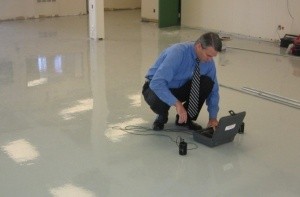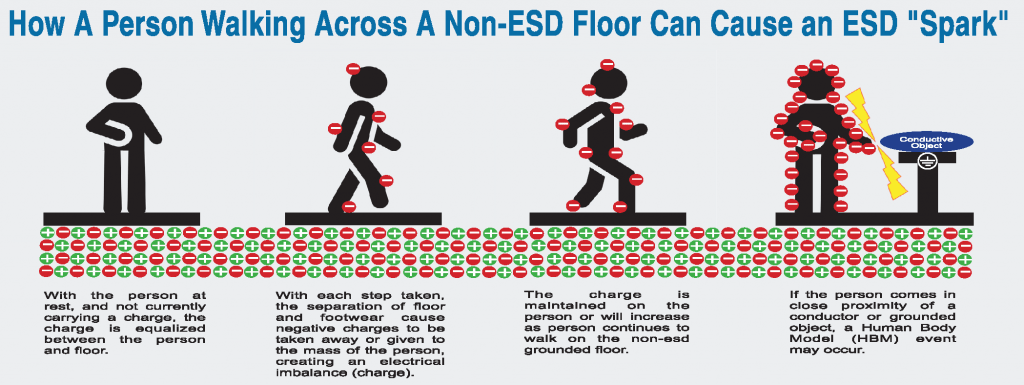 What Is ESD Flooring, How Does how does esd flooring work, and Why Do We Need It?
What Is ESD Flooring, How Does how does esd flooring work, and Why Do We Need It?
An ESD Flooring system serves as a conduit for electrical static charge (known as BVG or Body Voltage Generation accumulation on a person from movement across a polymer floor) to discharge to a desired controlled ground point. This directed and intentional flow of electrical current and discharge helps to greatly reduce or eliminate the potential of accidental electrostatic discharge, which can damage sensitive electronic components during manufacture. Even the smallest, and usually un-noticed, ESD discharge can have adverse effects on sensitive electronic components. With today’s smaller and more electrostatically-sensitive microchip components and printed circuit boards (PCB’s), manufacturers have been tasked with developing ESD-control and prevention programs to limit component failure and scrap rates as part of their quality control and manufacturing processes.
How Does ESD Flooring Work?
An ESD floor coating contains a conductive particle within its matrix which renders the coating to be electrically active in such a way that electrical current can travel through it. Much like a wire, it is able to carry electrical charge from one point to another. This is unlike wood, plastic, or glass, which are known insulators and unable to carry an electrical current. Most paints or polymer coatings do not have this property. In an ESD Protected Area (EPA), this type of floor works in conjunction with various other ESD protection devices, such as footwear, garments, and grounding straps to accomplish the task of minimizing BVG and controlling proper grounded discharge. Hopefully this was able to answer your question of, how does esd flooring work?
Why Is This Important?
The risk of unwanted static discharge consequence can range from extremely critical (life threatening), as in the case of unwanted spark generation causing an explosion in flammable environments, to more general, as in the case of eliminating static discharge nuisance with persons experiencing a mild “shock”.
Most often, the need for an ESD Floor (usually as a critical component of an entire ESD program) is necessary in the electronics industry. This is especially true in circuit board assembly and production. These circuit boards contain thousands of microscopic electric circuits that can be destroyed or “fried” with very small jolts of static discharge. In essence, static discharge onto one of these circuit boards has the same effect of blowing a fuse or circuit breaker in your home. Some of these failures can be immediately detected in the quality control process. These failures are categorized as catastrophic failures. Some failures, however, are so minor that they are not detected in quality control and the product with the faulty circuit board part is shipped out to the end user or consumer market. These failures, known as latent failures, usually occur quickly when the product is put to use out in the field. As you can surmise, these types of failures result in unexpected, costly warranty claims, and can tarnish an electronic component manufacturer’s reputation.
An ESD Flooring system, when installed and utilized as part of an entire ESD-control and prevention program, can work to limit both types of failures, thereby contributing to a lower scrap rates and a healthier bottom line.
Is static control a concern in your business processes? Protective Industrial Polymers offers a complete line of ESD-Control Flooring Systems. Click here to learn more about InhibiStat ESD-Control Flooring Systems.



